�
Data Structures and
Algorithms in Java™
Sixth Edition
Michael T. Goodrich
Department of Computer Science
University of California, Irvine
Roberto Tamassia
Department of Computer Science
Brown University
Michael H. Goldwasser
Department of Mathematics and Computer Science
Saint Louis University
�
Vice President and Executive Publisher
Executive Editor
Assistant Marketing Manager
Sponsoring Editor
Project Editor
Associate Production Manager
Cover Designer
Don Fowley
Beth Lang Golub
Debbie Martin
Mary O’Sullivan
Ellen Keohane
Joyce Poh
Kenji Ngieng
This book was set in LATEX by the authors, and printed and bound by RR Donnelley. The
cover was printed by RR Donnelley.
Trademark Acknowledgments: Java is a trademark of Oracle Corporation. Unix ® is a
registered trademark in the United States and other countries, licensed through X/Open
Company, Ltd. PowerPoint ® is a trademark of Microsoft Corporation. All other product
names mentioned herein are the trademarks of their respective owners.
This book is printed on acid free paper.
Founded in 1807, John Wiley & Sons, Inc. has been a valued source of knowledge and
understanding for more than 200 years, helping people around the world meet their needs
and fulfill their aspirations. Our company is built on a foundation of principles that include
responsibility to the communities we serve and where we live and work.
In 2008, we
launched a Corporate Citizenship Initiative, a global effort to address the environmental,
social, economic, and ethical challenges we face in our business. Among the issues we
are addressing are carbon impact, paper specifications and procurement, ethical conduct
within our business and among our vendors, and community and charitable support. For
more information, please visit our website: www.wiley.com/go/citizenship.
Copyright © 2014, 2010 John Wiley & Sons, Inc. All rights reserved. No part of this publi-
cation may be reproduced, stored in a retrieval system or transmitted in any form or by any
means, electronic, mechanical, photocopying, recording, scanning or otherwise, except
as permitted under Sections 107 or 108 of the 1976 United States Copyright Act, with-
out either the prior written permission of the Publisher, or authorization through payment
of the appropriate per-copy fee to the Copyright Clearance Center, Inc. 222 Rosewood
Drive, Danvers, MA 01923, website www.copyright.com. Requests to the Publisher for
permission should be addressed to the Permissions Department, John Wiley & Sons, Inc.,
111 River Street, Hoboken, NJ 07030-5774, (201) 748-6011, fax (201) 748-6008, website
http://www.wiley.com/go/ permissions.
Evaluation copies are provided to qualified academics and professionals for review pur-
poses only, for use in their courses during the next academic year. These copies are licensed
and may not be sold or transferred to a third party. Upon completion of the review period,
please return the evaluation copy to Wiley. Return instructions and a free of charge return
mailing label are available at www.wiley.com/go/returnlabel. If you have chosen to adopt
this textbook for use in your course, please accept this book as your complimentary desk
copy. Outside of the United States, please contact your local sales representative.
ISBN: 978-1-118-77133-4 (paperback)
Printed in the United States of America
10 9 8 7 6 5 4 3 2 1
�
To Karen, Paul, Anna, and Jack
– Michael T. Goodrich
To Isabel
– Roberto Tamassia
To Susan, Calista, and Maya
– Michael H. Goldwasser
�
�
Preface to the Sixth Edition
Data Structures and Algorithms in Java provides an introduction to data structures
and algorithms, including their design, analysis, and implementation. The major
changes in this sixth edition include the following:
• We redesigned the entire code base to increase clarity of presentation and
consistency in style and convention, including reliance on type inference, as
introduced in Java 7, to reduce clutter when instantiating generic types.
• We added 38 new figures, and redesigned 144 existing figures.
• We revised and expanded exercises, bringing the grand total to 794 exercises!
We continue our approach of dividing them into reinforcement, creativity,
and project exercises. However, we have chosen not to reset the number-
ing scheme with each new category, thereby avoiding possible ambiguity
between exercises such as R-7.5, C-7.5, P-7.5.
• The introductory chapters contain additional examples of classes and inheri-
tance, increased discussion of Java’s generics framework, and expanded cov-
erage of cloning and equivalence testing in the context of data structures.
• A new chapter, dedicated to the topic of recursion, provides comprehensive
coverage of material that was previously divided within Chapters 3, 4, and
9 of the fifth edition, while newly introducing the use of recursion when
processing file systems.
• We provide a new empirical study of the efficiency of Java’s StringBuilder
class relative to the repeated concatenation of strings, and then discuss the
theoretical underpinnings of its amortized performance.
• We provide increased discussion of iterators, contrasting between so-called
lazy iterators and snapshot iterators, with examples of both styles of imple-
mentation for several data structures.
• We have increased the use of abstract base classes to reduce redundancy
when providing multiple implementations of a common interface, and the
use of nested classes to provide greater encapsulation for our data structures.
• We have included complete Java implementations for many data structures
and algorithms that were only described with pseudocode in earlier editions.
These new implementations include both array-based and linked-list-based
queue implementations, a heap-based adaptable priority queue, a bottom-up
heap construction, hash tables with either separate chaining or linear probing,
splay trees, dynamic programming for the least-common subsequence prob-
lem, a union-find data structure with path compression, breadth-first search
of a graph, the Floyd-Warshall algorithm for computing a graph’s transitive
closure, topological sorting of a DAG, and both the Prim-Jarn´ık and Kruskal
algorithms for computing a minimum spanning tree.
v
�
vi
Prerequisites
Preface
We assume that the reader is at least vaguely familiar with a high-level program-
ming language, such as C, C++, Python, or Java, and that he or she understands the
main constructs from such a high-level language, including:
• Variables and expressions
• Methods (also known as functions or procedures)
• Decision structures (such as if-statements and switch-statements)
• Iteration structures (for-loops and while-loops)
For readers who are familiar with these concepts, but not with how they are ex-
pressed in Java, we provide a primer on the Java language in Chapter 1. Still, this
book is primarily a data structures book, not a Java book; hence, it does not provide
a comprehensive treatment of Java. Nevertheless, we do not assume that the reader
is necessarily familiar with object-oriented design or with linked structures, such
as linked lists, for these topics are covered in the core chapters of this book.
In terms of mathematical background, we assume the reader is somewhat famil-
iar with topics from high-school mathematics. Even so, in Chapter 4, we discuss
the seven most-important functions for algorithm analysis. In fact, sections that use
something other than one of these seven functions are considered optional, and are
indicated with a star (⋆).
Online Resources
This book is accompanied by an extensive set of online resources, which can be
found at the following website:
www.wiley.com/college/goodrich
Included on this website is a collection of educational aids that augment the topics
of this book, for both students and instructors. For all readers, and especially for
students, we include the following resources:
• All Java source code presented in this book
• An appendix of useful mathematical facts
• PDF handouts of PowerPoint slides (four-per-page)
• A study guide with hints to exercises, indexed by problem number
For instructors using this book, we include the following additional teaching aids:
• Solutions to hundreds of the book’s exercises
• Color versions of all figures and illustrations from the book
• Slides in PowerPoint and PDF (one-per-page) format
The slides are fully editable, so as to allow an instructor using this book full free-
dom in customizing his or her presentations.
�
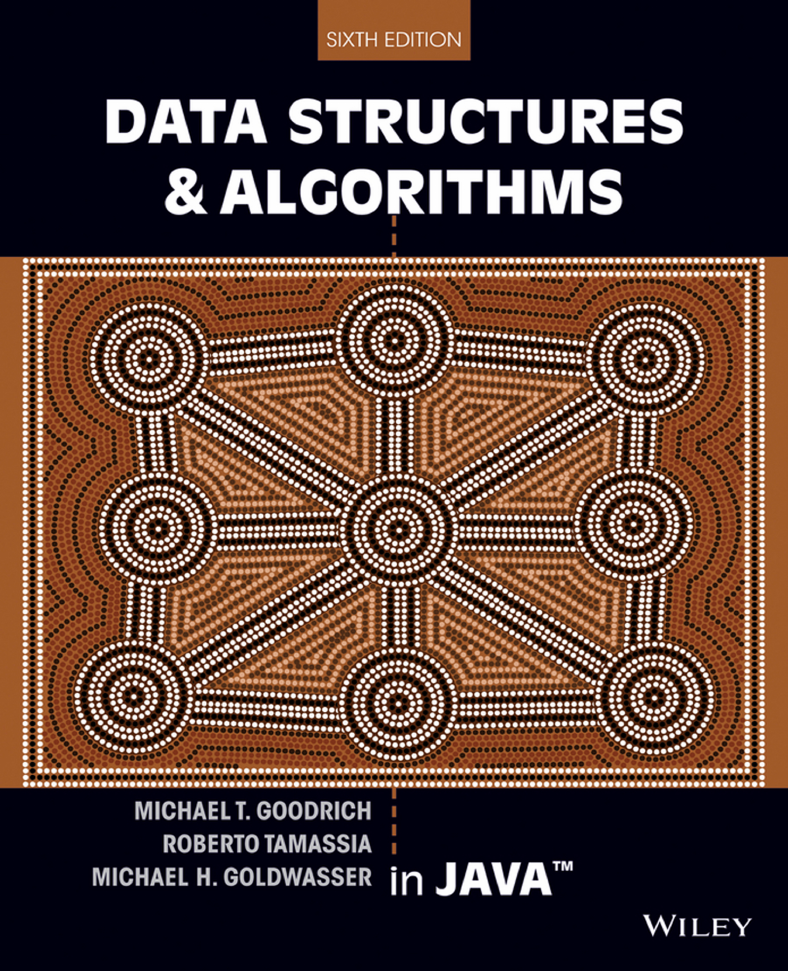

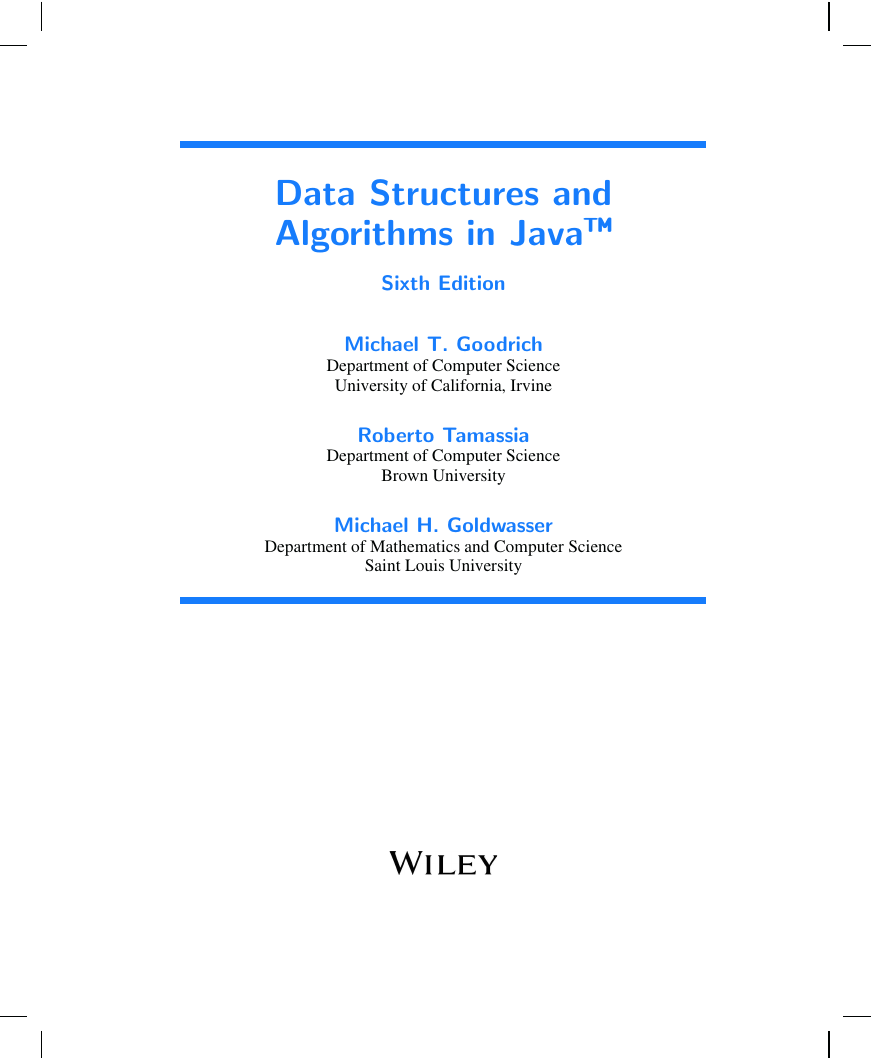
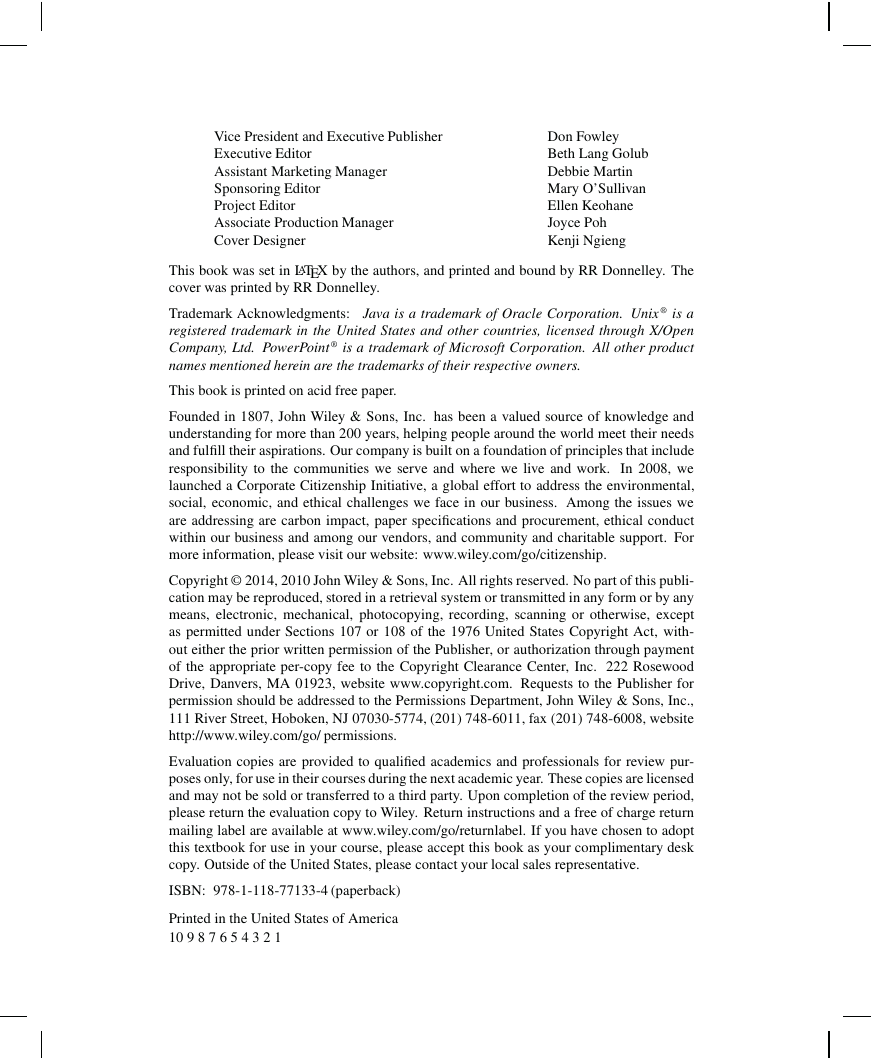
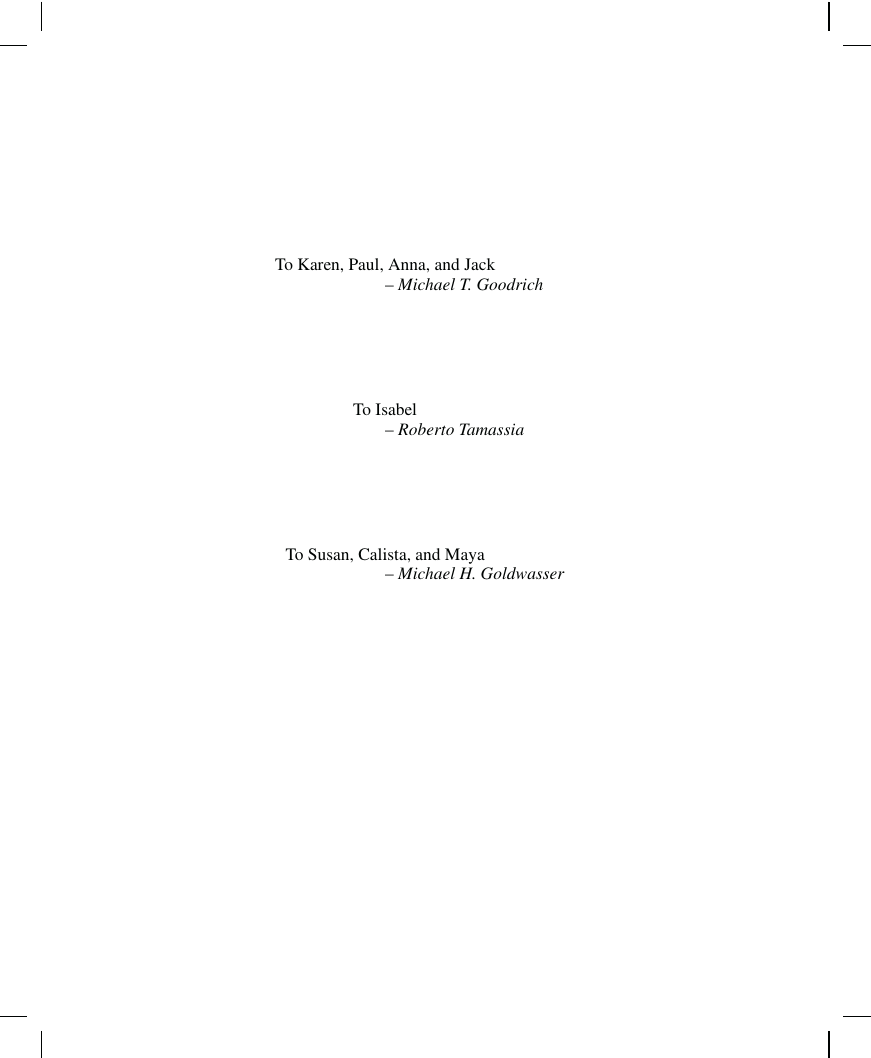

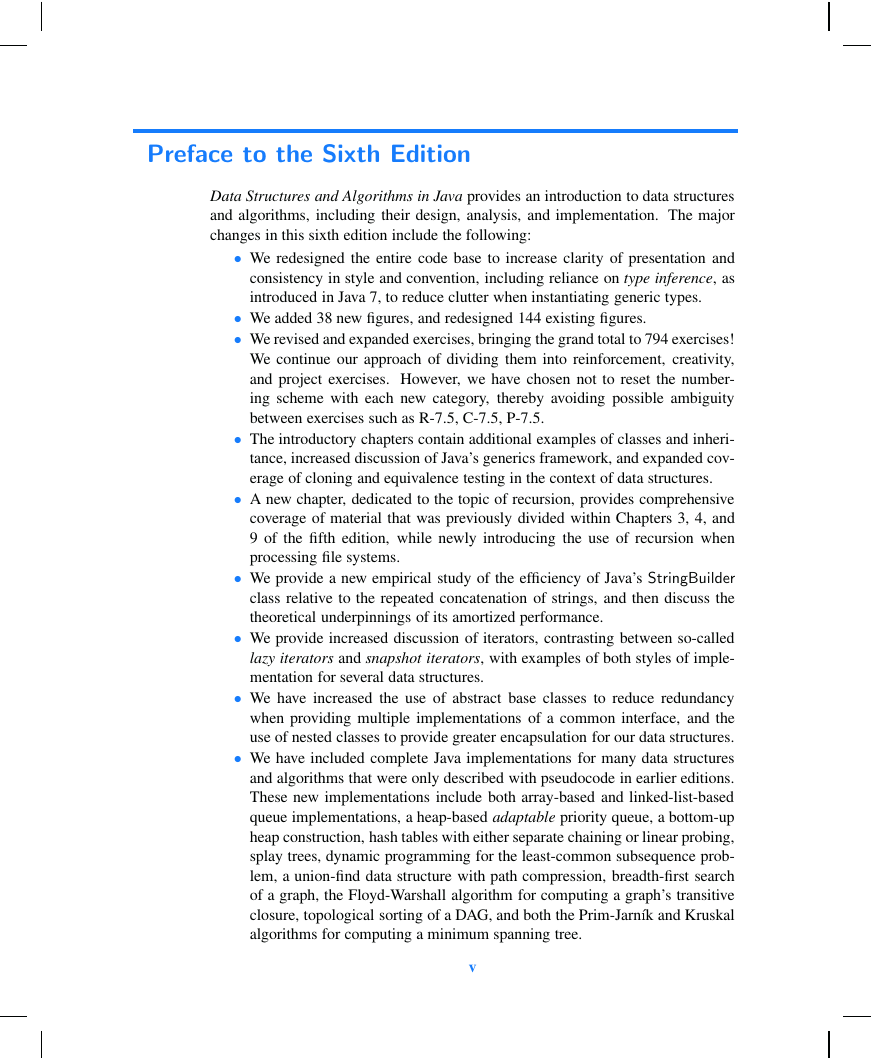
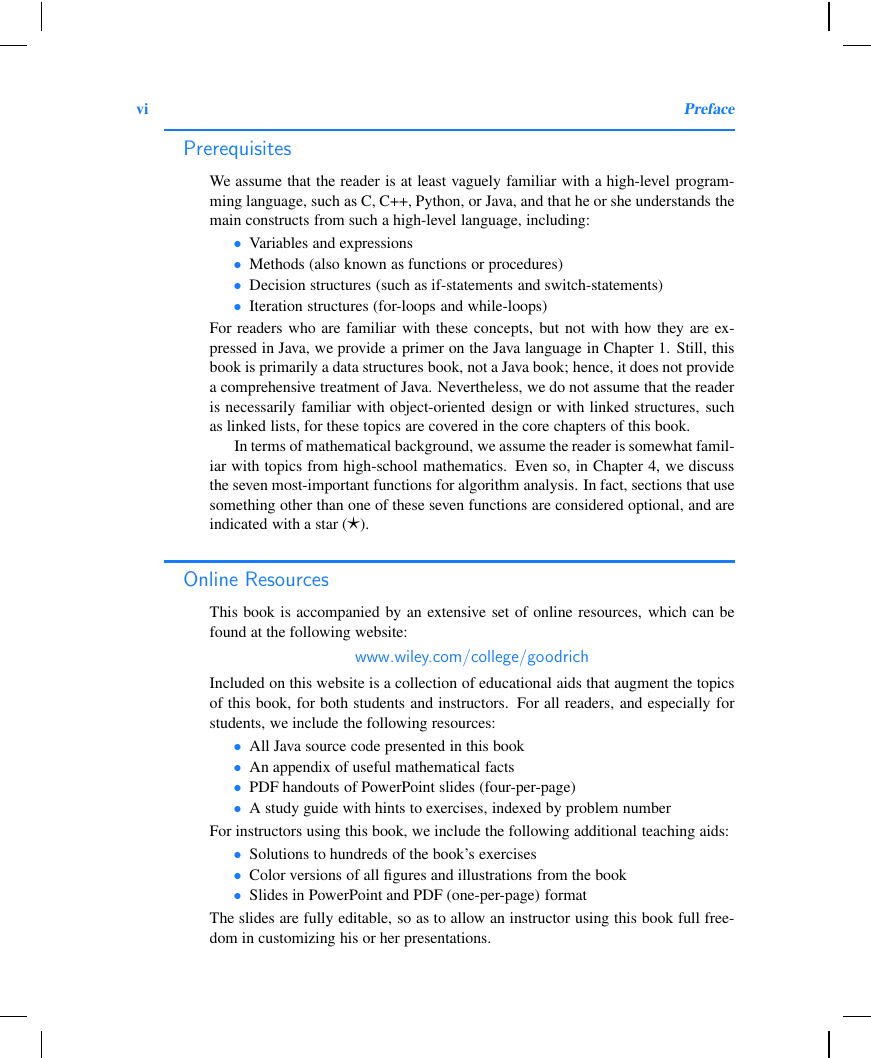








 2023年江西萍乡中考道德与法治真题及答案.doc
2023年江西萍乡中考道德与法治真题及答案.doc 2012年重庆南川中考生物真题及答案.doc
2012年重庆南川中考生物真题及答案.doc 2013年江西师范大学地理学综合及文艺理论基础考研真题.doc
2013年江西师范大学地理学综合及文艺理论基础考研真题.doc 2020年四川甘孜小升初语文真题及答案I卷.doc
2020年四川甘孜小升初语文真题及答案I卷.doc 2020年注册岩土工程师专业基础考试真题及答案.doc
2020年注册岩土工程师专业基础考试真题及答案.doc 2023-2024学年福建省厦门市九年级上学期数学月考试题及答案.doc
2023-2024学年福建省厦门市九年级上学期数学月考试题及答案.doc 2021-2022学年辽宁省沈阳市大东区九年级上学期语文期末试题及答案.doc
2021-2022学年辽宁省沈阳市大东区九年级上学期语文期末试题及答案.doc 2022-2023学年北京东城区初三第一学期物理期末试卷及答案.doc
2022-2023学年北京东城区初三第一学期物理期末试卷及答案.doc 2018上半年江西教师资格初中地理学科知识与教学能力真题及答案.doc
2018上半年江西教师资格初中地理学科知识与教学能力真题及答案.doc 2012年河北国家公务员申论考试真题及答案-省级.doc
2012年河北国家公务员申论考试真题及答案-省级.doc 2020-2021学年江苏省扬州市江都区邵樊片九年级上学期数学第一次质量检测试题及答案.doc
2020-2021学年江苏省扬州市江都区邵樊片九年级上学期数学第一次质量检测试题及答案.doc 2022下半年黑龙江教师资格证中学综合素质真题及答案.doc
2022下半年黑龙江教师资格证中学综合素质真题及答案.doc